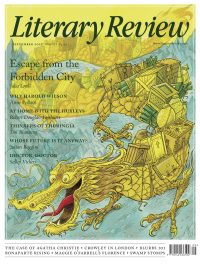C P W Gammell
How to Mate a Glacier
Himalaya: Exploring the Roof of the World
By John Keay
Bloomsbury 432pp £30
John Keay has devoted a lifetime to the study of the Himalayas, India and China, demonstrating in his writings and broadcasts both a wide-ranging curiosity and a searching intellect. In his new book, Himalaya, in prose that feels as effortless as it is entertaining, Keay paints a quite fascinating picture of this magical region, covering everything from geology, glaciers, tectonic plates and botany to the spiritual and religious evolution of humans. Tibetan history is set alongside Western interactions with the mountains and all that they contain. This is also a history of science and of man’s desire to codify, possess and control through knowledge. Empire looms large, the imperial powers converging on Tibet and suffocating its independence and customs.
On the infamous 1903–4 Francis Younghusband expedition to Lhasa, a British military mission to establish diplomatic relations in the region and resolve a border dispute between Tibet and Sikkim, the journalist Edmund Candler observed, ‘Perhaps before we turn our backs on the mystery of Tibet we will realise that the lamas despise us as gross materialists and philistines – we who are always groping and grasping after the particular, while they are absorbed in the sublime and the universal.’ Among the many themes of this book, perhaps this one struck me most forcibly: the face-off between different traditions, one characterised by a desire for knowledge and control, power and authority, and the other by a desire for transcendence, connectedness and universality.
Yet scientific discoveries have, in their way, underscored such ideas of connectedness and universality. What was once underwater is now above ground: the Himalayas contain tropical fossils from the ocean floor. In the 19th-century, British botanists and explorers, chief among them Joseph Dalton Hooker and Henry Haversham Godwin-Austen,

Sign Up to our newsletter
Receive free articles, highlights from the archive, news, details of prizes, and much more.@Lit_Review
Follow Literary Review on Twitter
Twitter Feed
Under its longest-serving editor, Graydon Carter, Vanity Fair was that rare thing – a New York society magazine that published serious journalism.
@PeterPeteryork looks at what Carter got right.
Peter York - Deluxe Editions
Peter York: Deluxe Editions - When the Going Was Good: An Editor’s Adventures During the Last Golden Age of Magazines by Graydon Carter
literaryreview.co.uk
Henry James returned to America in 1904 with three objectives: to see his brother William, to deliver a series of lectures on Balzac, and to gather material for a pair of books about modern America.
Peter Rose follows James out west.
Peter Rose - The Restless Analyst
Peter Rose: The Restless Analyst - Henry James Comes Home: Rediscovering America in the Gilded Age by Peter Brooks...
literaryreview.co.uk
Vladimir Putin served his apprenticeship in the KGB toward the end of the Cold War, a period during which Western societies were infiltrated by so-called 'illegals'.
Piers Brendon examines how the culture of Soviet spycraft shaped his thinking.
Piers Brendon - Tinker, Tailor, Sleeper, Troll
Piers Brendon: Tinker, Tailor, Sleeper, Troll - The Illegals: Russia’s Most Audacious Spies and the Plot to Infiltrate the West by Shaun Walker
literaryreview.co.uk